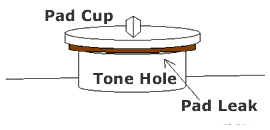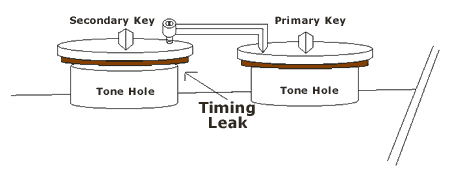The Two Basic Types of Leaks
By Curt Altarac
Before a technician attempts to remove leaks, he must figure out which of the two basic types of leaks he is dealing with, a pad leak or a timing leak.

Pad Leaks

Pad leaks are the first leaks that we need to address when repairing woodwinds. It is impossible to repair any timing leaks before leaks in the pads are under control. As with many problems Pad leaks can only be addressed one pad at a time.
A pad leak occurs when one part of the pad touches the tone-hole before another part of the pad. When the pad closes, the entire circumference of the pad should come in contact with the tone-hole at the same time.
All saxophones leak because it is impossible to get a piece of leather-wrapped-felt and a ring of metal to make contact at the EXACT same moment around the diameter of the pad. As a repairer you have to decide how exacting you want to be. The more exact you are the better the instrument will respond and the easier it will be to set the pad timing. It is not uncommon for me to spend several days play testing and removing leaks on my professional overhauls so that every pad has settled and seals 'perfectly'.
Timing Leaks

Pad Timing is the ability of two or more pads on a mechanism to close at the same time. When the pad timing on an instrument is not properly set, a Timing Leak results. More specifically, pad timing is the ability of one pad to close against the tone-hole while operating a linkage that lowers another pad at the same time.
Although pad timing can sometimes involve many pads, it is best to only concern yourself with 2 pads at a time. Often pad 'A' will close pad 'B' and pad 'B' will close pad 'C'. In this case make sure that Pad 'A' will close pad 'B' at the proper time and then, check the timing between Pads 'B' and 'C'. If there is not too much give in the mechanism pad 'A' and pad 'C' will close at the same time.
Because Pad Timing is set by adjustments in spacing material between keys, it is best to use a material that will hold an adjustment. The traditional material for this has been natural sheet cork. Cork is decent silencer, is easy to adjust and produces an aesthetically pleasing result when properly cut. Because of its ease of use I would recommend natural cork to any technician who is just starting to learn the trade of repair or for student work. However, there is one large draw back to using natural cork for this purpose; cork compresses over time. Because of this flaw I have found that adjustments in natural cork are not permanent. TechCork is a much more effective material for timing issues. Although it is not as easy to sand as natural cork, the results are more permanent because this material does not compress over time. TechCork also offers good silencing properties. Using Tech Cork in the adjustment areas of your woodwind instrument will allow for a more solid and permanent repair and fewer leaks over a longer period of time.
Copyright © 2000-2012
MusicMedic.com
All Rights Reserved